Abstract
Although antimicrobial agents are effective therapy for early Lyme disease, optimal treatment schedules have not been conclusively established. The efficacy of various dosages of eight antibiotics used for borreliosis treatment was evaluated for C3H/HeNCrIBR mice, which reproducibly develop persistent infection, arthritis, and carditis when inoculated with Borrelia burgdorferi. Amoxicillin-clavulanic acid, ceftriaxone, and high-dose penicillin G effectively eliminated infection and disease. Oxytetracycline, doxycycline, chloramphenicol, erythromycin, and azithromycin failed to cure infected mice. There was a correlation between peak serum antibiotic concentrations in mice, as determined by agar well diffusion bioassays, and therapeutic levels in humans. When experimentally inoculated mice were treated at 1 week postinfection with ceftriaxone (16 mg/kg of body weight twice daily for 5 days) and monitored for up to 90 days, all treated mice were free of spirochetes and had no gross or histologic lesions. This antibiotic regimen at days 7 to 11 postinoculation eliminated the spirochetes so that there were no relapses during the 90-day observation period. For experimentally inoculated mice treated with ceftriaxone at 7 or 14 days postinfection, arthritis, carditis, and infection were eliminated. When treatment began at 30 and 90 days after inoculation, infection and active cardiac and arthritic lesions were eradicated; however, residual mild synovitis and vasculitis persisted in some mice. In comparison with inoculated, untreated mice, ceftriaxone therapy at 7, 14, 30, and 90 days postinfection abrogated the development of antibody titers against B. burgdorferi. Having the potential to determine the presence of the spirochete through culture and histologic lesions makes the B. burgdorferi-inoculated C3H mouse model a valuable adjunct in evaluating chemotherapeutic options for Lyme disease.
Full text
PDF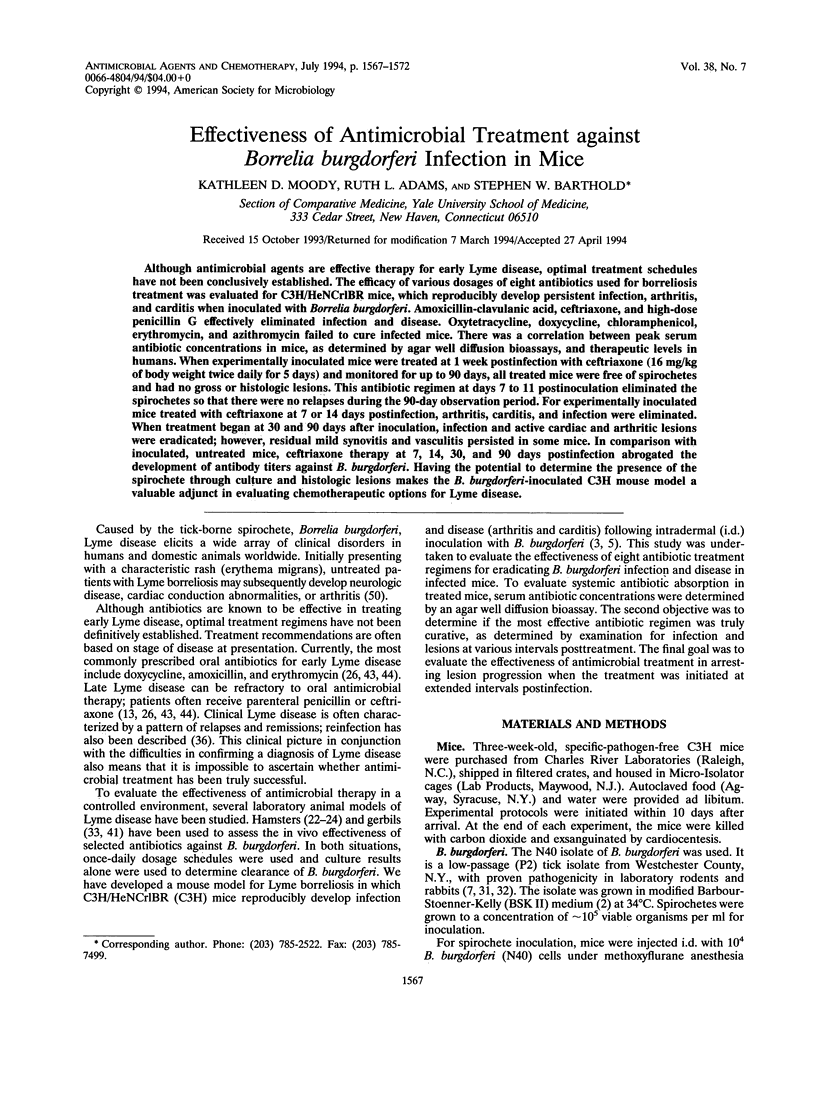
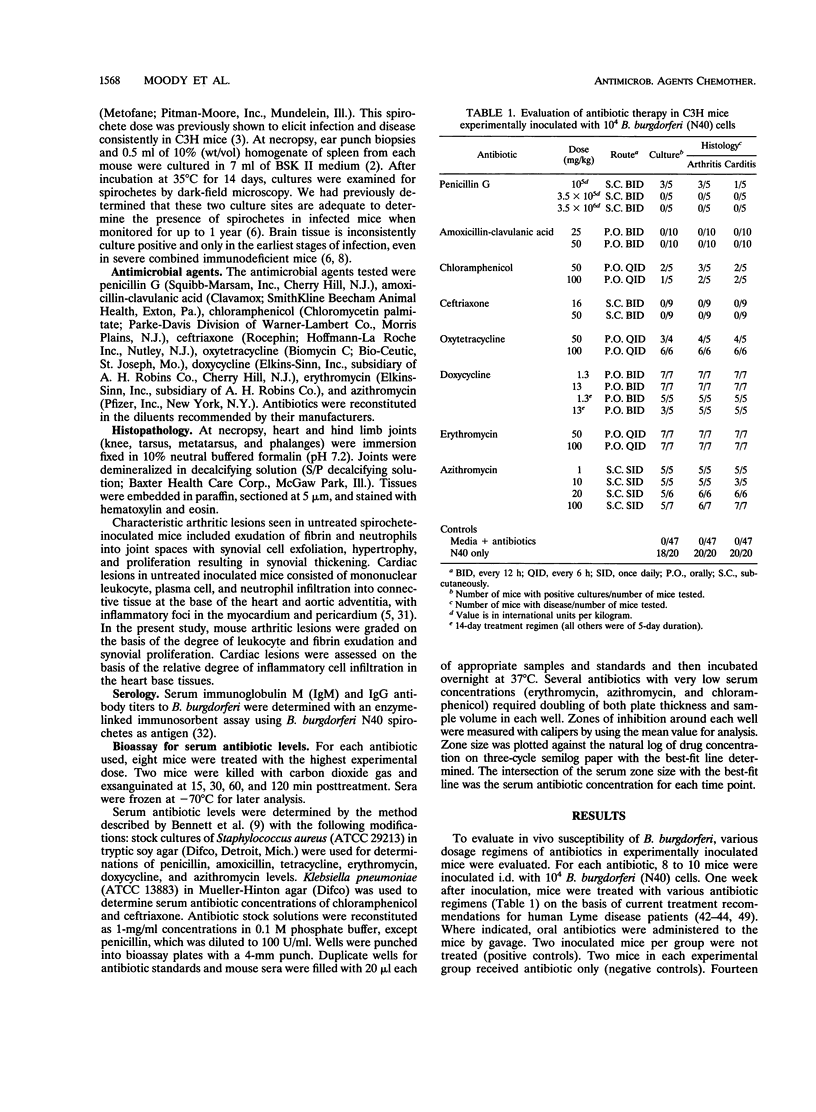
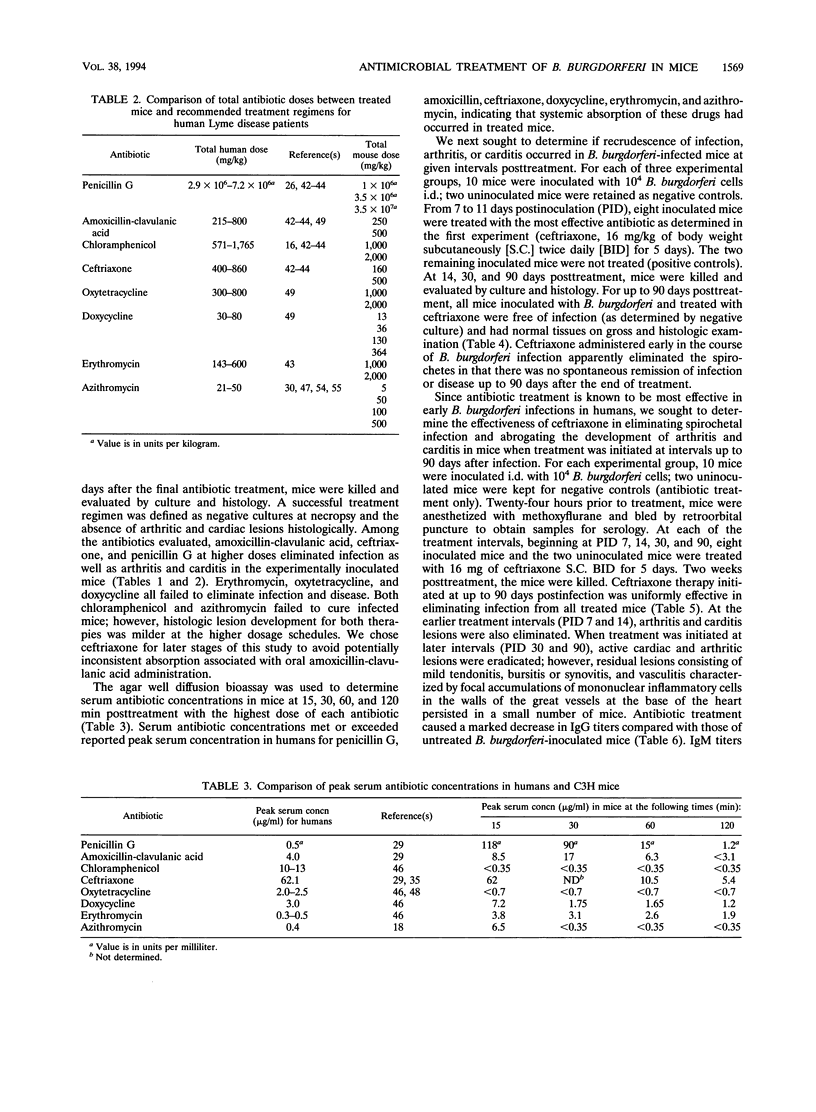
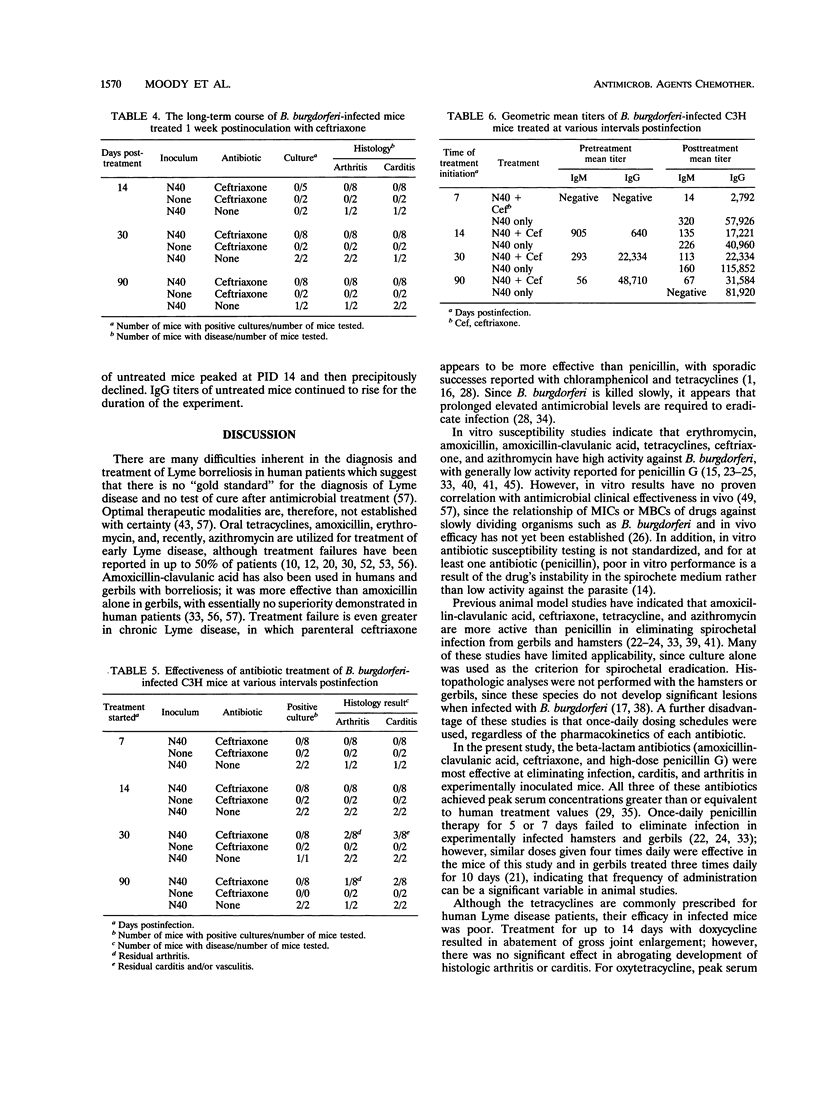
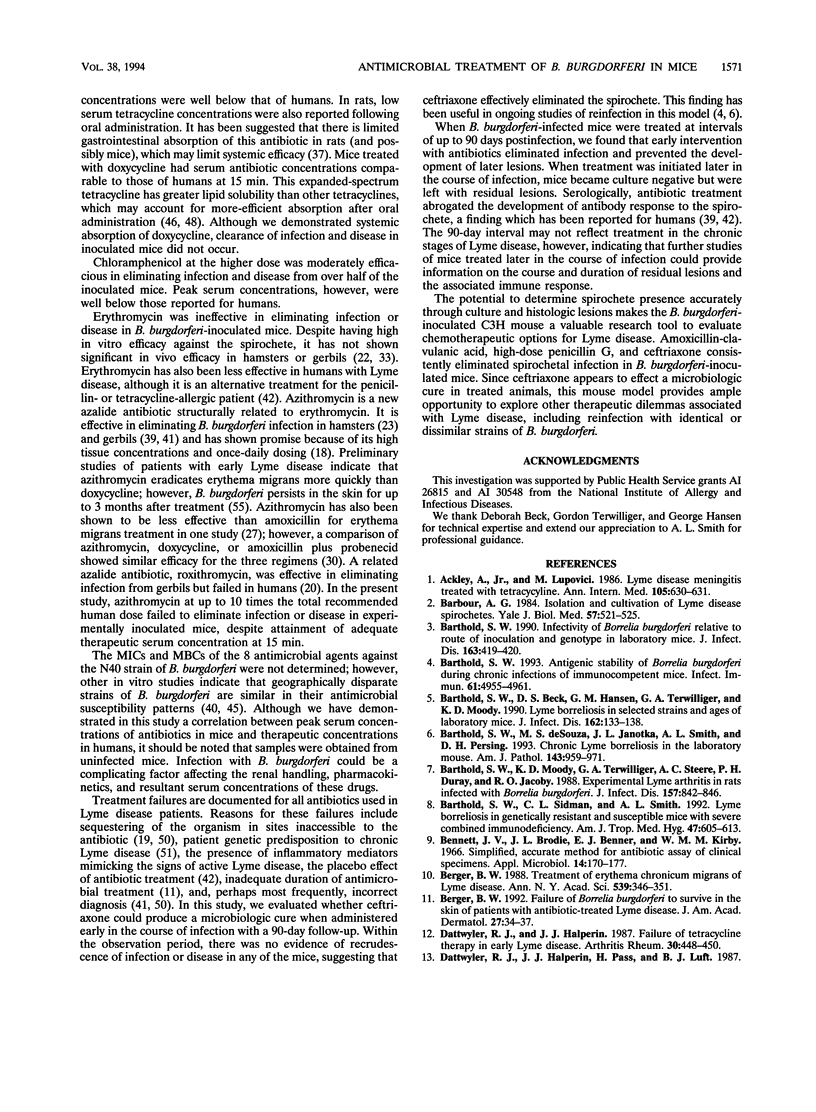
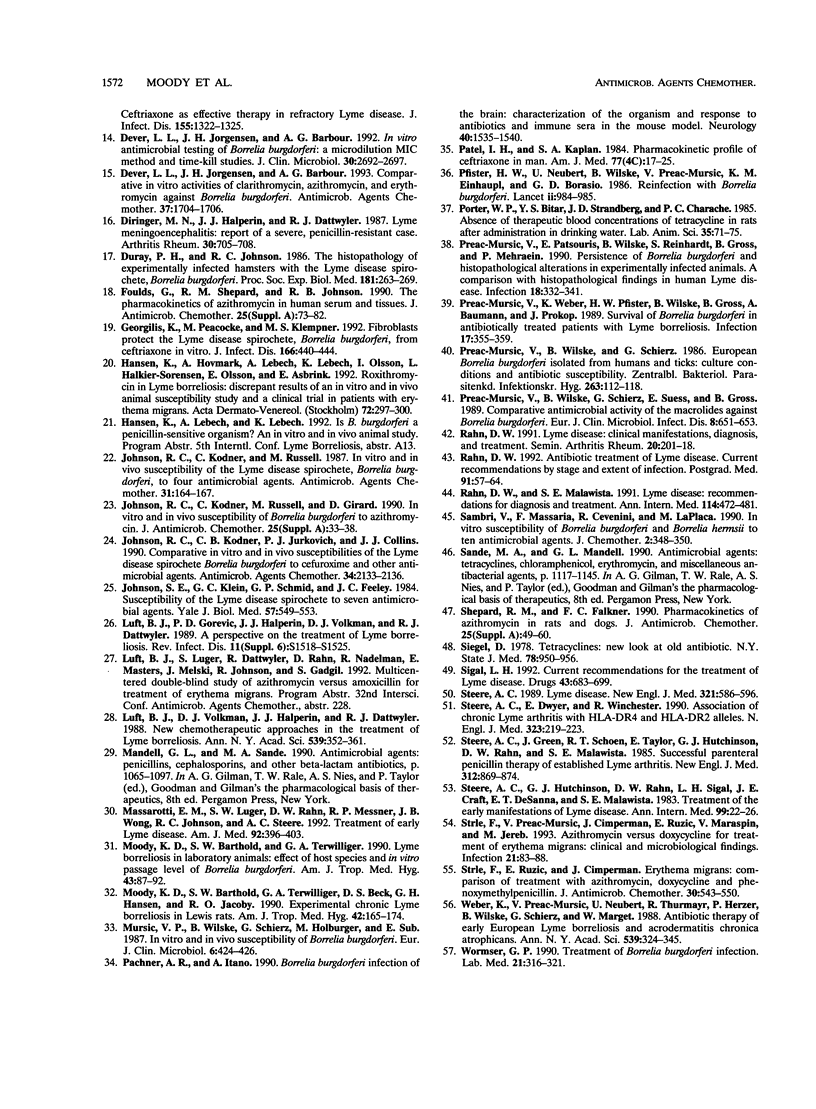
Selected References
These references are in PubMed. This may not be the complete list of references from this article.
- Ackley A., Jr, Lupovici M. Lyme-disease meningitis treated with tetracycline. Ann Intern Med. 1986 Oct;105(4):630–631. doi: 10.7326/0003-4819-105-4-630_2. [DOI] [PubMed] [Google Scholar]
- Barbour A. G. Isolation and cultivation of Lyme disease spirochetes. Yale J Biol Med. 1984 Jul-Aug;57(4):521–525. [PMC free article] [PubMed] [Google Scholar]
- Barthold S. W. Antigenic stability of Borrelia burgdorferi during chronic infections of immunocompetent mice. Infect Immun. 1993 Dec;61(12):4955–4961. doi: 10.1128/iai.61.12.4955-4961.1993. [DOI] [PMC free article] [PubMed] [Google Scholar]
- Barthold S. W., Beck D. S., Hansen G. M., Terwilliger G. A., Moody K. D. Lyme borreliosis in selected strains and ages of laboratory mice. J Infect Dis. 1990 Jul;162(1):133–138. doi: 10.1093/infdis/162.1.133. [DOI] [PubMed] [Google Scholar]
- Barthold S. W. Infectivity of Borrelia burgdorferi relative to route of inoculation and genotype in laboratory mice. J Infect Dis. 1991 Feb;163(2):419–420. doi: 10.1093/infdis/163.2.419. [DOI] [PubMed] [Google Scholar]
- Barthold S. W., Moody K. D., Terwilliger G. A., Duray P. H., Jacoby R. O., Steere A. C. Experimental Lyme arthritis in rats infected with Borrelia burgdorferi. J Infect Dis. 1988 Apr;157(4):842–846. doi: 10.1093/infdis/157.4.842. [DOI] [PubMed] [Google Scholar]
- Barthold S. W., Sidman C. L., Smith A. L. Lyme borreliosis in genetically resistant and susceptible mice with severe combined immunodeficiency. Am J Trop Med Hyg. 1992 Nov;47(5):605–613. doi: 10.4269/ajtmh.1992.47.605. [DOI] [PubMed] [Google Scholar]
- Barthold S. W., de Souza M. S., Janotka J. L., Smith A. L., Persing D. H. Chronic Lyme borreliosis in the laboratory mouse. Am J Pathol. 1993 Sep;143(3):959–971. [PMC free article] [PubMed] [Google Scholar]
- Bennett J. V., Brodie J. L., Benner E. J., Kirby W. M. Simplified, accurate method for antibiotic assay of clinical specimens. Appl Microbiol. 1966 Mar;14(2):170–177. doi: 10.1128/am.14.2.170-177.1966. [DOI] [PMC free article] [PubMed] [Google Scholar]
- Berger B. W., Johnson R. C., Kodner C., Coleman L. Failure of Borrelia burgdorferi to survive in the skin of patients with antibiotic-treated Lyme disease. J Am Acad Dermatol. 1992 Jul;27(1):34–37. doi: 10.1016/0190-9622(92)70152-6. [DOI] [PubMed] [Google Scholar]
- Berger B. W. Treatment of erythema chronicum migrans of Lyme disease. Ann N Y Acad Sci. 1988;539:346–351. doi: 10.1111/j.1749-6632.1988.tb31868.x. [DOI] [PubMed] [Google Scholar]
- Dattwyler R. J., Halperin J. J. Failure of tetracycline therapy in early Lyme disease. Arthritis Rheum. 1987 Apr;30(4):448–450. doi: 10.1002/art.1780300414. [DOI] [PubMed] [Google Scholar]
- Dever L. L., Jorgensen J. H., Barbour A. G. Comparative in vitro activities of clarithromycin, azithromycin, and erythromycin against Borrelia burgdorferi. Antimicrob Agents Chemother. 1993 Aug;37(8):1704–1706. doi: 10.1128/aac.37.8.1704. [DOI] [PMC free article] [PubMed] [Google Scholar]
- Dever L. L., Jorgensen J. H., Barbour A. G. In vitro antimicrobial susceptibility testing of Borrelia burgdorferi: a microdilution MIC method and time-kill studies. J Clin Microbiol. 1992 Oct;30(10):2692–2697. doi: 10.1128/jcm.30.10.2692-2697.1992. [DOI] [PMC free article] [PubMed] [Google Scholar]
- Diringer M. N., Halperin J. J., Dattwyler R. J. Lyme meningoencephalitis: report of a severe, penicillin-resistant case. Arthritis Rheum. 1987 Jun;30(6):705–708. [PubMed] [Google Scholar]
- Duray P. H., Johnson R. C. The histopathology of experimentally infected hamsters with the Lyme disease spirochete, Borrelia burgdorferi. Proc Soc Exp Biol Med. 1986 Feb;181(2):263–269. doi: 10.3181/00379727-181-42251. [DOI] [PubMed] [Google Scholar]
- Foulds G., Shepard R. M., Johnson R. B. The pharmacokinetics of azithromycin in human serum and tissues. J Antimicrob Chemother. 1990 Jan;25 (Suppl A):73–82. doi: 10.1093/jac/25.suppl_a.73. [DOI] [PubMed] [Google Scholar]
- Georgilis K., Peacocke M., Klempner M. S. Fibroblasts protect the Lyme disease spirochete, Borrelia burgdorferi, from ceftriaxone in vitro. J Infect Dis. 1992 Aug;166(2):440–444. doi: 10.1093/infdis/166.2.440. [DOI] [PubMed] [Google Scholar]
- Hansen K., Hovmark A., Lebech A. M., Lebech K., Olsson I., Halkier-Sørensen L., Olsson E., Asbrink E. Roxithromycin in Lyme borreliosis: discrepant results of an in vitro and in vivo animal susceptibility study and a clinical trial in patients with erythema migrans. Acta Derm Venereol. 1992 Aug;72(4):297–300. [PubMed] [Google Scholar]
- Johnson R. C., Kodner C. B., Jurkovich P. J., Collins J. J. Comparative in vitro and in vivo susceptibilities of the Lyme disease spirochete Borrelia burgdorferi to cefuroxime and other antimicrobial agents. Antimicrob Agents Chemother. 1990 Nov;34(11):2133–2136. doi: 10.1128/aac.34.11.2133. [DOI] [PMC free article] [PubMed] [Google Scholar]
- Johnson R. C., Kodner C., Russell M., Girard D. In-vitro and in-vivo susceptibility of Borrelia burgdorferi to azithromycin. J Antimicrob Chemother. 1990 Jan;25 (Suppl A):33–38. doi: 10.1093/jac/25.suppl_a.33. [DOI] [PubMed] [Google Scholar]
- Johnson R. C., Kodner C., Russell M. In vitro and in vivo susceptibility of the Lyme disease spirochete, Borrelia burgdorferi, to four antimicrobial agents. Antimicrob Agents Chemother. 1987 Feb;31(2):164–167. doi: 10.1128/aac.31.2.164. [DOI] [PMC free article] [PubMed] [Google Scholar]
- Johnson S. E., Klein G. C., Schmid G. P., Feeley J. C. Susceptibility of the Lyme disease spirochete to seven antimicrobial agents. Yale J Biol Med. 1984 Jul-Aug;57(4):549–553. [PMC free article] [PubMed] [Google Scholar]
- Luft B. J., Gorevic P. D., Halperin J. J., Volkman D. J., Dattwyler R. J. A perspective on the treatment of Lyme borreliosis. Rev Infect Dis. 1989 Sep-Oct;11 (Suppl 6):S1518–S1525. doi: 10.1093/clinids/11.supplement_6.s1518. [DOI] [PubMed] [Google Scholar]
- Luft B. J., Volkman D. J., Halperin J. J., Dattwyler R. J. New chemotherapeutic approaches in the treatment of Lyme borreliosis. Ann N Y Acad Sci. 1988;539:352–361. doi: 10.1111/j.1749-6632.1988.tb31869.x. [DOI] [PubMed] [Google Scholar]
- Massarotti E. M., Luger S. W., Rahn D. W., Messner R. P., Wong J. B., Johnson R. C., Steere A. C. Treatment of early Lyme disease. Am J Med. 1992 Apr;92(4):396–403. doi: 10.1016/0002-9343(92)90270-l. [DOI] [PubMed] [Google Scholar]
- Moody K. D., Barthold S. W., Terwilliger G. A., Beck D. S., Hansen G. M., Jacoby R. O. Experimental chronic Lyme borreliosis in Lewis rats. Am J Trop Med Hyg. 1990 Feb;42(2):165–174. doi: 10.4269/ajtmh.1990.42.165. [DOI] [PubMed] [Google Scholar]
- Moody K. D., Barthold S. W., Terwilliger G. A. Lyme borreliosis in laboratory animals: effect of host species and in vitro passage of Borrelia burgdorferi. Am J Trop Med Hyg. 1990 Jul;43(1):87–92. doi: 10.4269/ajtmh.1990.43.87. [DOI] [PubMed] [Google Scholar]
- Mursic V. P., Wilske B., Schierz G., Holmburger M., Süss E. In vitro and in vivo susceptibility of Borrelia burgdorferi. Eur J Clin Microbiol. 1987 Aug;6(4):424–426. doi: 10.1007/BF02013102. [DOI] [PubMed] [Google Scholar]
- Pachner A. R., Itano A. Borrelia burgdorferi infection of the brain: characterization of the organism and response to antibiotics and immune sera in the mouse model. Neurology. 1990 Oct;40(10):1535–1540. doi: 10.1212/wnl.40.10.1535. [DOI] [PubMed] [Google Scholar]
- Patel I. H., Kaplan S. A. Pharmacokinetic profile of ceftriaxone in man. Am J Med. 1984 Oct 19;77(4C):17–25. [PubMed] [Google Scholar]
- Pfister H. W., Neubert U., Wilske B., Preac-Mursic V., Einhäupl K. M., Borasio G. D. Reinfection with Borrelia burgdorferi. Lancet. 1986 Oct 25;2(8513):984–985. doi: 10.1016/s0140-6736(86)90640-9. [DOI] [PubMed] [Google Scholar]
- Porter W. P., Bitar Y. S., Strandberg J. D., Charache P. C. Absence of therapeutic blood concentrations of tetracycline in rats after administration in drinking water. Lab Anim Sci. 1985 Feb;35(1):71–75. [PubMed] [Google Scholar]
- Preac Mursic V., Patsouris E., Wilske B., Reinhardt S., Gross B., Mehraein P. Persistence of Borrelia burgdorferi and histopathological alterations in experimentally infected animals. A comparison with histopathological findings in human Lyme disease. Infection. 1990 Nov-Dec;18(6):332–341. doi: 10.1007/BF01646399. [DOI] [PubMed] [Google Scholar]
- Preac-Mursic V., Weber K., Pfister H. W., Wilske B., Gross B., Baumann A., Prokop J. Survival of Borrelia burgdorferi in antibiotically treated patients with Lyme borreliosis. Infection. 1989 Nov-Dec;17(6):355–359. doi: 10.1007/BF01645543. [DOI] [PubMed] [Google Scholar]
- Preac-Mursic V., Wilske B., Schierz G. European Borrelia burgdorferi isolated from humans and ticks culture conditions and antibiotic susceptibility. Zentralbl Bakteriol Mikrobiol Hyg A. 1986 Dec;263(1-2):112–118. doi: 10.1016/s0176-6724(86)80110-9. [DOI] [PubMed] [Google Scholar]
- Preac-Mursic V., Wilske B., Schierz G., Süss E., Gross B. Comparative antimicrobial activity of the new macrolides against Borrelia burgdorferi. Eur J Clin Microbiol Infect Dis. 1989 Jul;8(7):651–653. doi: 10.1007/BF01968150. [DOI] [PubMed] [Google Scholar]
- Rahn D. W. Antibiotic treatment of Lyme disease. Current recommendations by stage and extent of infection. Postgrad Med. 1992 May 15;91(7):57–64. doi: 10.1080/00325481.1992.11701343. [DOI] [PubMed] [Google Scholar]
- Rahn D. W. Lyme disease: clinical manifestations, diagnosis, and treatment. Semin Arthritis Rheum. 1991 Feb;20(4):201–218. doi: 10.1016/0049-0172(91)90017-t. [DOI] [PubMed] [Google Scholar]
- Rahn D. W., Malawista S. E. Lyme disease: recommendations for diagnosis and treatment. Ann Intern Med. 1991 Mar 15;114(6):472–481. doi: 10.7326/0003-4819-114-6-472. [DOI] [PubMed] [Google Scholar]
- Sambri V., Massaria F., Cevenini R., La Placa M. In-vitro susceptibility of Borrelia burgdorferi and Borrelia hermsii to ten antimicrobial agents. J Chemother. 1990 Dec;2(6):348–350. doi: 10.1080/1120009x.1990.11739041. [DOI] [PubMed] [Google Scholar]
- Shepard R. M., Falkner F. C. Pharmacokinetics of azithromycin in rats and dogs. J Antimicrob Chemother. 1990 Jan;25 (Suppl A):49–60. doi: 10.1093/jac/25.suppl_a.49. [DOI] [PubMed] [Google Scholar]
- Siegel D. Tetracyclines: new look at old antibiotic. I. Clinical pharmacology, mechanism of action, and untoward effects. N Y State J Med. 1978 May;78(6):950–956. [PubMed] [Google Scholar]
- Sigal L. H. Current recommendations for the treatment of Lyme disease. Drugs. 1992 May;43(5):683–699. doi: 10.2165/00003495-199243050-00005. [DOI] [PubMed] [Google Scholar]
- Steere A. C., Dwyer E., Winchester R. Association of chronic Lyme arthritis with HLA-DR4 and HLA-DR2 alleles. N Engl J Med. 1990 Jul 26;323(4):219–223. doi: 10.1056/NEJM199007263230402. [DOI] [PubMed] [Google Scholar]
- Steere A. C., Green J., Schoen R. T., Taylor E., Hutchinson G. J., Rahn D. W., Malawista S. E. Successful parenteral penicillin therapy of established Lyme arthritis. N Engl J Med. 1985 Apr 4;312(14):869–874. doi: 10.1056/NEJM198504043121401. [DOI] [PubMed] [Google Scholar]
- Steere A. C., Hutchinson G. J., Rahn D. W., Sigal L. H., Craft J. E., DeSanna E. T., Malawista S. E. Treatment of the early manifestations of Lyme disease. Ann Intern Med. 1983 Jul;99(1):22–26. doi: 10.7326/0003-4819-99-1-22. [DOI] [PubMed] [Google Scholar]
- Steere A. C. Lyme disease. N Engl J Med. 1989 Aug 31;321(9):586–596. doi: 10.1056/NEJM198908313210906. [DOI] [PubMed] [Google Scholar]
- Strle F., Preac-Mursic V., Cimperman J., Ruzic E., Maraspin V., Jereb M. Azithromycin versus doxycycline for treatment of erythema migrans: clinical and microbiological findings. Infection. 1993 Mar-Apr;21(2):83–88. doi: 10.1007/BF01710737. [DOI] [PubMed] [Google Scholar]
- Weber K., Preac-Mursic V., Neubert U., Thurmayr R., Herzer P., Wilske B., Schierz G., Marget W. Antibiotic therapy of early European Lyme borreliosis and acrodermatitis chronica atrophicans. Ann N Y Acad Sci. 1988;539:324–345. doi: 10.1111/j.1749-6632.1988.tb31867.x. [DOI] [PubMed] [Google Scholar]


